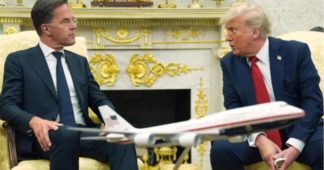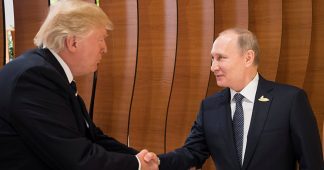By Prof. Ruel F. Pepa* – Global Research
July 15, 2025
U.S. President Donald Trump has sharply escalated his confrontational approach to foreign policy, issuing a series of hardline statements and policy threats that have reverberated across the international community. In a dramatic shift that has alarmed both global allies and adversaries, Trump announced sweeping new demands directed at the governments of Russia and China which he has frequently accused of undermining U.S. interests and global stability.
On July 14, during a high-profile press conference in Washington, Trump delivered a stark ultimatum to Russian President Vladimir Putin, giving him 50 days to end the ongoing war in Ukraine. Should Russia fail to meet this deadline, Trump warned that the United States would impose unprecedented punitive measures.
These include a blanket 100% tariff on all Russian imports and the implementation of secondary sanctions designed to penalize third-party nations that continue to trade in Russian oil and gas. The move, which would significantly escalate the economic pressure on Moscow, signals a renewed attempt to force an end to the conflict through economic isolation.
In a parallel development, the release of controversial audio recordings has intensified scrutiny of Trump’s rhetoric and diplomatic tactics. In the recordings whose authenticity has not been disputed by Trump’s team, the President can be heard recounting private conversations with both Putin and Chinese President Xi Jinping. In these exchanges,
Trump reportedly issued blunt and alarming threats, warning that any further acts of aggression in Ukraine or Taiwan could provoke direct U.S. military retaliation, including bombing the respective capitals of Moscow and Beijing.
The implications of these remarks have sparked immediate concern among U.S. allies in Europe and Asia, many of whom view such overt threats of military action as dangerously provocative. Critics have labeled the strategy “reckless brinkmanship,” warning that it could further destabilize already tense geopolitical flashpoints. Others, however, have praised Trump’s uncompromising tone as a necessary deterrent against authoritarian expansionism.
The President’s tough rhetoric has been matched by concrete policy moves. In tandem with his ultimatum to Russia, Trump announced a renewed military aid package to Ukraine, featuring advanced weapons systems and logistical support. Additionally, his administration has begun working with congressional leaders on a new round of bipartisan sanctions legislation targeting key sectors of the Russian and Chinese economies.
As reactions pour in from across diplomatic and defense circles, the full impact of Trump’s new approach remains to be seen. With international tensions already running high, the President’s bold strategy is certain to shape global relations in the months ahead either as a catalyst for de-escalation or as a trigger for deeper conflict.
A Sudden Pivot on Russia
President Donald Trump’s newly announced 50-day deadline for Russia to end its war in Ukraine represents a significant and unexpected shift in the administration’s foreign policy. After months of ambiguous rhetoric and inconsistent support for Kyiv, the White House is now adopting a markedly more aggressive stance toward Moscow that has surprised both allies and critics alike.
This policy reversal is underscored by a concrete escalation in military assistance to Ukraine. For the first time under Trump’s renewed term, the U.S. is expected to deliver Patriot air defense missile systems as part of a broader NATO-coordinated security assistance package. These highly sophisticated systems are designed to intercept incoming missiles and aircraft, and their deployment would bolster Ukraine’s ability to defend key cities and infrastructure against Russian aerial assaults. However, all possibilities considered and studied, the extensively lethal firepower of Russia’s non-nuclear Oreshnik could be a different story aimed at challenging the capability of the sophisticated Patriot missile systems.
The decision comes amid mounting pressure from both European allies and bipartisan voices in Congress urging the administration to adopt a firmer approach to what is inaccurately perceived as Russian aggression. European leaders, particularly from frontline NATO states such as Poland and the Baltic nations, have expressed growing concern over perceived U.S. hesitancy in confronting Moscow. Within Congress, frustration has also been building over the lack of a clear and consistent policy on Ukraine, leading to renewed legislative efforts aimed at intensifying economic pressure on the Kremlin.
Central to this push is the proposed “Sanctioning Russia Act,” currently making its way through the Senate. The sweeping legislation contains some of the harshest economic penalties ever contemplated against Russia. Among its key provisions are tariffs of up to 500% on select Russian goods, as well as automatic sanctions targeting third-party countries, companies, and financial institutions that continue to facilitate Russian energy exports. These measures aim to close existing loopholes that have allowed Russia to re-route oil and gas sales through intermediaries, often evading Western sanctions.
The bill, co-sponsored by Senator Lindsey Graham (R-SC) and Senator Richard Blumenthal (D-CT), represents a rare moment of bipartisan consensus on foreign policy. In many ways, it mirrors the tone and content of Trump’s recent public declarations, suggesting a growing alignment between the executive branch and lawmakers on the need to increase pressure on Vladimir Putin’s regime.
Critics, however, warn that the administration’s abrupt pivot paired with Trump’s characteristic bombast risks heightening global tensions without a clear diplomatic exit ramp. Other less perceptive analysts view it as a long-overdue recalibration, aligning U.S. strategy with the urgency of the war in Ukraine and the need to reaffirm the illusion of American leadership on the world stage while seemingly forgetful of Russia’s Karaganov Option whose operationalization has long been overdue.
Either way, Trump’s 50-day ultimatum and the legislative momentum behind the Sanctioning Russia Act have set the stage for a new and potentially explosive phase in the U.S.-Russia relations.
Escalating Tensions with China
While President Donald Trump’s recent ultimatum to Russia has captured global headlines, perhaps even more alarming to diplomatic observers are his newly revealed comments regarding China and the status of Taiwan. In an audio recording obtained from a closed-door fundraiser held in late 2024 and set to be published in an upcoming political memoir, Trump is heard recounting a private exchange with Chinese President Xi Jinping in which he explicitly threatened a direct U.S. military strike on Beijing if China were to launch a military invasion of Taiwan.
The stark warning, which departs dramatically from decades of U.S. diplomatic practice, has sent shockwaves through foreign policy and national security circles. For over four decades, successive American administrations have adhered to a careful policy of “strategic ambiguity” on Taiwan: pledging support for the island’s self-defense while avoiding overt commitments that could provoke Beijing or embolden Taiwanese calls for independence. This balancing act has allowed the U.S. to deter aggression while preserving diplomatic ties with China under the framework of the One China policy.
Trump’s blunt and unambiguous threat, however, marks a decisive break from that tradition. According to the leaked recording, Trump told donors that he had warned Xi “directly and personally” that any Chinese move against Taiwan would be met with immediate and devastating retaliation, including a strike “at the heart of Beijing.” The remark, characterized by some analysts as shockingly incendiary, has been interpreted as a signal that the U.S. might no longer seek to obscure its red lines when it comes to defending Taiwan.
To date, the Chinese government has not issued a formal response. State-run media outlets have briefly acknowledged the reports, but have largely downplayed the incident, framing it as campaign bluster or rhetorical exaggeration intended for a domestic political audience. Analysts suggest that Beijing’s muted reaction is intentional, being part of a broader effort to avoid inflaming nationalist sentiment or appearing to validate the credibility of Trump’s threat.
Nonetheless, experts warn that such rhetoric, especially if perceived as a genuine shift in U.S. policy, carries significant risks.
“This kind of language can drastically increase the chances of strategic miscalculation,” said Bonnie Glaser, a leading expert on U.S.-China relations. “If either side begins to believe the other is preparing for preemptive action, the potential for conflict rises exponentially.”
Military analysts have also expressed concern that Trump’s comments could trigger escalatory dynamics in the Taiwan Strait, particularly at a time when Chinese military exercises around the island have become more frequent and aggressive. The People’s Liberation Army (PLA) has conducted several high-profile naval and air drills near Taiwan in recent months, and any sign that Washington is abandoning diplomatic nuance could prompt Beijing to accelerate its timetable or rethink its assumptions about U.S. restraint.
Meanwhile, U.S. allies in the Indo-Pacific, including Japan, South Korea, and Australia, have quietly sought clarification from Washington about the administration’s position. While some regional leaders have welcomed Trump’s tough posture as a strong deterrent, others fear that such rhetoric could reduce diplomatic flexibility and force a binary confrontation with Beijing that few nations are eager to join.
With both the Taiwan issue and U.S.-China relations entering an increasingly volatile phase, Trump’s off-the-cuff comment may prove to be more than just a moment of bravado as it could represent a profound turning point in the decades-long effort to keep peace across the Taiwan Strait.
A Global Game of Chicken
At the heart of the escalating geopolitical crisis is a troubling and unresolved question: not whether President Donald Trump will act on his incendiary threats toward Russia and China, but how those threats will be interpreted by Moscow and Beijing. In an increasingly volatile international environment, where miscommunication can carry catastrophic consequences, the risk lies as much in perception as in action.
Both Russia and China are not merely regional powers but nuclear-armed superpowers with advanced and rapidly modernizing military capabilities. Russia possesses one of the world’s largest stockpiles of nuclear warheads, alongside a suite of cutting-edge technologies, including hypersonic glide vehicles, intercontinental ballistic missiles (ICBMs) capable of reaching the continental United States, and offensive cyber warfare tools that have already been deployed in past conflicts. China, meanwhile, has dramatically expanded its nuclear arsenal, modernized its naval and space capabilities, and invested heavily in artificial intelligence-driven military platforms. Both nations are now fully capable of projecting force far beyond their borders and responding in kind to perceived threats.
In this high-stakes environment, Trump’s recent pronouncements threatening direct military action against both Moscow and Beijing are being scrutinized through a lens of strategic calculus. Intelligence analysts and foreign policy experts warn that if these threats are taken at face value, they could trigger defensive mobilizations or even preemptive moves. Conversely, if they are dismissed as political bluster, adversaries might test U.S. resolve by escalating their own actions in Ukraine or Taiwan, thereby increasing the chances of a real-world confrontation.
Nowhere is this tension felt more acutely than in Europe, where U.S. allies are watching these developments with growing alarm. Many European leaders have not forgotten Trump’s past critical accusations of NATO that members were “free-riding” on American defense spending, and repeated suggestions that the
U.S. might reconsider its commitment to Article 5, the alliance’s mutual defense clause. These earlier signals of disengagement are now colliding with a new, seemingly hyper-aggressive posture, leaving allies uncertain about Washington’s true intentions.
The result is a profound sense of strategic disorientation within NATO and the broader transatlantic alliance. European capitals are now grappling with a scenario in which they may be drawn into a major military conflict or potentially even a nuclear standoff not through a deliberate policy of collective defense, but via unilateral decisions made by a U.S. president viewed by many as volatile, impulsive, and politically driven.
The core dilemma is thus one of credibility versus control. Trump’s threats may be intended to deter aggression through sheer force of rhetoric, but they also risk reducing the space for diplomacy, crisis management, and de-escalation. In an age of interlinked deterrence systems and lightning-fast military technologies, the margin for error is dangerously small.
As one senior European diplomat, speaking anonymously, put it: “We’re caught between a rock and a hard place i.e., between adversaries testing boundaries, and an American leader who might redraw them at any moment.”
In this emerging global game of chicken, the risks are existential and the world is left holding its breath, hoping that no side blinks the wrong way.
Between Bluster and Catastrophe
As the world reels from President Donald Trump’s dramatic threats against both Russia and China, a sharp divide has emerged among foreign policy experts and intelligence analysts over how seriously to take his words. To some, Trump’s fiery rhetoric promising military strikes on Moscow and Beijing if red lines are crossed represents little more than political theater: an aggressive performance crafted to reinforce his image as a no-nonsense strongman in the lead-up to the 2026 midterm elections.
These critics point to a familiar pattern. Throughout his political career, Trump has relied heavily on spectacle and confrontation to galvanize his base, dominate media cycles, and outmaneuver political rivals. His past threats whether to withdraw from NATO, “totally destroy” North Korea, or impose massive tariffs have often been walked back or quietly diluted. Viewed through this lens, his latest declarations may be calculated provocations, designed more for domestic consumption than for execution on the world stage.
However, others urge a far more cautious interpretation. They warn that Trump has a history of transforming what initially appear to be empty threats into actual policy shifts often with global consequences. From the withdrawal from the Iran nuclear deal to the abrupt assassination of Iranian General Qasem Soleimani, there is precedent for impulsive decisions made in defiance of conventional diplomatic wisdom. In each case, allies and adversaries alike were forced to rapidly reassess their assumptions about the reliability and predictability of U.S. strategy.
The deeper concern now is that the ambiguity of Trump’s intentions could be as dangerous as the threats themselves. In the high-stakes arenas of global military competition, where response times are measured in minutes and deterrence hinges on credible signaling, misreading an adversary’s resolve can be catastrophic.
Should either Russia or China interpret Trump’s rhetoric as not only credible but imminent particularly if paired with heightened U.S. military activity or sanctions, they might choose to act preemptively, fearing that inaction would leave them more vulnerable.
And while both nations have traditionally avoided direct military conflict with the U.S., the increasingly blurred lines between deterrence, provocation, and escalation raise the prospect of a miscalculated first strike. Such a move, even if limited in scope, be it a cyberattack, a naval incident, or a targeted missile strike, could ignite a broader conflict that neither side intended.
Disturbingly, some security experts now entertain a once-unthinkable scenario: a large-scale war reaching U.S. soil for the first time in modern history. While the continental United States has long been shielded by geography, that strategic buffer has eroded with the rise of long-range precision weaponry, hypersonic missiles, and cyberwarfare capabilities. Both Russia and China now possess the tools to strike U.S. infrastructure, communications networks, military bases, and even civilian targets with devastating speed and reach.
In this precarious environment, Trump’s confrontational style which is long seen as a tool of negotiation or branding may carry new and unprecedented risks. The difference between bluster and catastrophe, analysts warn, lies not only in intent, but in interpretation. And in a world armed with weapons that can cross oceans in minutes, that margin for error may prove fatally thin.
The Path Forward
To avoid such a dire scenario, many in Washington are urging a return to diplomatic norms and institutional oversight.
Congressional restraint: Lawmakers are pushing for measures that would limit unilateral military action by the president, including mandatory consultation before the use of force against nuclear-armed states.
- Allied reassurance: Diplomats from Germany, France, and the UK have initiated quiet conversations with their U.S. counterparts to ensure that military escalation is not imminent.
- Clearer communication: Pentagon officials have reportedly begun backchannel communications with Moscow and Beijing to de-escalate tensions and clarify U.S. intentions.
Conclusion
President Donald Trump’s recent threats against Russia and China delivered with characteristic bravado may be aimed at projecting strength and deterring aggression. Yet beneath the surface of these calculated provocations lies a far more dangerous reality: the potential to plunge the world into an era-defining crisis. In seeking to demonstrate resolve, the United States may instead be fanning the flames of a confrontation that could spiral beyond control.
What’s at stake is not merely the strategic balance between superpowers or the fate of contested regions like Ukraine and Taiwan. The implications are far broader, threatening the stability of entire regions, the safety of U.S. allies and partners, and the fragile architecture of global peace painstakingly built over the past seven decades.
Trump’s threat of direct military strikes on Moscow and Beijing in the event of further aggression represents a jarring departure from the language of diplomacy. They ignore decades of precedent rooted in deterrence through ambiguity, and instead veer into the territory of ultimatum and preemption. In an age where nuclear-armed states possess hypersonic weapons, cyberwarfare capabilities, and precision-guided strike systems, such rhetoric risks triggering defensive postures, accidental escalations, or even miscalculations that could prove irreversible.
History offers sobering lessons. Wars are not always ignited by tanks crossing borders or missiles launched into the night sky. Often, they begin with words that harden positions, corner adversaries, and collapse the diplomatic space that exists between tension and violence. In the lead-up to both World Wars, it was inflammatory rhetoric and rigid posturing that set the stage for disaster. And in the nuclear era, the margin for error is perilously thin.
What makes this moment uniquely perilous is the uncertainty surrounding Trump’s intent. Are his declarations sincere expressions of policy, or political theater designed to stir domestic fervor ahead of the 2026 midterms? The world’s adversaries and its allies are left to guess. That ambiguity, combined with the unprecedented scale of the threats, creates an unstable geopolitical climate where any misstep could ignite a global firestorm.
In the past, American strength has often been measured by its capacity to lead with restraint, to assert power without courting catastrophe. In this case, strength may lie not in the volume of threats issued, but in the wisdom to deescalate before rhetoric becomes reality.
The world is watching. And as history has shown, words once spoken can shape destinies. They can provoke, they can embolden, and sometimes, they can destroy. The choice, now, is whether they will be the spark that ends an era of relative peace or the warning that prevents its collapse.
*Prof. Ruel F. Pepa is a Filipino philosopher based in Madrid, Spain. A retired academic (Associate Professor IV), he taught Philosophy and Social Sciences for more than fifteen years at Trinity University of Asia, an Anglican university in the Philippines. He is a Research Associate of the Centre for Research on Globalization (CRG).
We remind our readers that publication of articles on our site does not mean that we agree with what is written. Our policy is to publish anything which we consider of interest, so as to assist our readers in forming their opinions. Sometimes we even publish articles with which we totally disagree, since we believe it is important for our readers to be informed on as wide a spectrum of views as possible.











